Showing Spotlights 497 - 504 of 559 in category All (newest first):
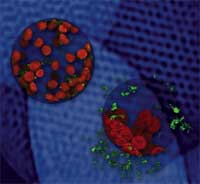 Most nanobiotechnology research today is focused on human medical applications and, mostly for testing and demonstration purposes, on animals. As nanotechnology is gaining interest with regard to agricultural applications, plant science research focusing on investigation of plant genomics and gene function as well as improvement of crop species has become a nanotechnology frontier. Plant cells differ from animal cells in several aspects, a major one being that they possess a wall surrounding them to provide, among other things, mechanical and structural support. The plant cell wall is generally made up of pollysacharides and cellulose. Cellulose provides a stiff and rigid environment for the cell to live in. Thanks to this wall, viruses have no active way of penetrating plant cells but rely on mechanical wounds or infected seeds for transmission. Researchers are commonly using surface-functionalized silica nanoparticles as nonviral nanocarriers for experimental drug and DNA delivery into animal cells but their use with plants so far was limited due to the cell wall. In a first demonstration of the utilization of porous nanoparticle materials for intracellular controlled release and gene transfer application in plants, researchers have used silica nanoparticles to penetrate the cell wall and deliver a payload into the cell.
Most nanobiotechnology research today is focused on human medical applications and, mostly for testing and demonstration purposes, on animals. As nanotechnology is gaining interest with regard to agricultural applications, plant science research focusing on investigation of plant genomics and gene function as well as improvement of crop species has become a nanotechnology frontier. Plant cells differ from animal cells in several aspects, a major one being that they possess a wall surrounding them to provide, among other things, mechanical and structural support. The plant cell wall is generally made up of pollysacharides and cellulose. Cellulose provides a stiff and rigid environment for the cell to live in. Thanks to this wall, viruses have no active way of penetrating plant cells but rely on mechanical wounds or infected seeds for transmission. Researchers are commonly using surface-functionalized silica nanoparticles as nonviral nanocarriers for experimental drug and DNA delivery into animal cells but their use with plants so far was limited due to the cell wall. In a first demonstration of the utilization of porous nanoparticle materials for intracellular controlled release and gene transfer application in plants, researchers have used silica nanoparticles to penetrate the cell wall and deliver a payload into the cell.
May 14th, 2007
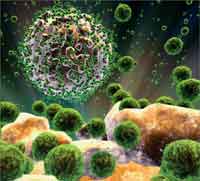 For centuries, man has searched for miracle cures to end suffering caused by disease and injury. Many researchers believe nanotechnology may be mankind's first "giant step" toward this goal. Whether these beliefs are based on facts or hope, many corporations and governments are willing to invest a great deal of money to find out what happens when nanotechnology is used for medical applications - the emerging field of nanomedicine. Hundreds of millions, if not billions of dollars have been invested by governments, such as the U.S. National Cancer Institute, and the private sector in nanomedicine research and nanotech-related life sciences ventures. The 2008 budget of the U.S. National Nanotechnology Initiative provides more than $200 million for the National Institutes of Health. The European Union, particularly Germany and the UK, and Japan are also investing heavily in this field. It is difficult to find fault with a technology that promises to cure cancer almost before it starts and prevent the spread of AIDS and other infectious diseases. Scientists around the globe are searching for ways to exploit nanoparticles to improve human health. However, there are toxicological concerns and ethical issues that come with nanomedicine and they have to be addressed alongside the benefits.
For centuries, man has searched for miracle cures to end suffering caused by disease and injury. Many researchers believe nanotechnology may be mankind's first "giant step" toward this goal. Whether these beliefs are based on facts or hope, many corporations and governments are willing to invest a great deal of money to find out what happens when nanotechnology is used for medical applications - the emerging field of nanomedicine. Hundreds of millions, if not billions of dollars have been invested by governments, such as the U.S. National Cancer Institute, and the private sector in nanomedicine research and nanotech-related life sciences ventures. The 2008 budget of the U.S. National Nanotechnology Initiative provides more than $200 million for the National Institutes of Health. The European Union, particularly Germany and the UK, and Japan are also investing heavily in this field. It is difficult to find fault with a technology that promises to cure cancer almost before it starts and prevent the spread of AIDS and other infectious diseases. Scientists around the globe are searching for ways to exploit nanoparticles to improve human health. However, there are toxicological concerns and ethical issues that come with nanomedicine and they have to be addressed alongside the benefits.
May 7th, 2007
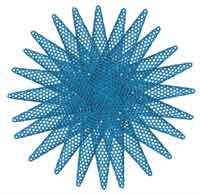 Currently, the most common carrier vehicles to deliver therapeutic drugs, genes or proteins to a patient's target cells are viruses that have been genetically altered to carry the desired payload. These viruses infect cells, deposit their payloads, and take over the cells' machinery to produce the desirable proteins. One problem with this method is that the human body has developed a very effective immune system that protects it from viral infections and another problem is that viral-based delivery vehicles may integrate into the host genome. Thanks to advances in nanotechnology fabrication techniques, the development of nonviral nanocarriers for gene and drug delivery has become possible. Besides viruses, polymeric systems and various inorganic nanomaterials are under intensive investigation as nonviral delivery vehicles. Finding new candidates for vehicles is still of great interest because most existing synthetic vehicles exhibit intrinsic cytotoxicity and show relatively low delivery efficiency. Enter the carbon nanohorn (CNH). This recently recognized member of the fullerene family has a unique dahlia flower-like structure, huge surface areas and can be fabricated with high purity. Researchers believe that CNHs may have potential advantages over normal nanoparticles, nanorods and nanotubes as synthetic intracellular delivery vehicles.
Currently, the most common carrier vehicles to deliver therapeutic drugs, genes or proteins to a patient's target cells are viruses that have been genetically altered to carry the desired payload. These viruses infect cells, deposit their payloads, and take over the cells' machinery to produce the desirable proteins. One problem with this method is that the human body has developed a very effective immune system that protects it from viral infections and another problem is that viral-based delivery vehicles may integrate into the host genome. Thanks to advances in nanotechnology fabrication techniques, the development of nonviral nanocarriers for gene and drug delivery has become possible. Besides viruses, polymeric systems and various inorganic nanomaterials are under intensive investigation as nonviral delivery vehicles. Finding new candidates for vehicles is still of great interest because most existing synthetic vehicles exhibit intrinsic cytotoxicity and show relatively low delivery efficiency. Enter the carbon nanohorn (CNH). This recently recognized member of the fullerene family has a unique dahlia flower-like structure, huge surface areas and can be fabricated with high purity. Researchers believe that CNHs may have potential advantages over normal nanoparticles, nanorods and nanotubes as synthetic intracellular delivery vehicles.
May 1st, 2007
 Nanotechnology has begun to find potential applications in the area of functional food by engineering biological molecules toward functions very different from those they have in nature, opening up a whole new area of research and development. Of course, there seems to be no limit to what food technologists are prepared to do to our food (read this delightful romp through the food processing industry to get the idea: "Twinkie, Deconstructed". For the non-U.S. reader: a Twinkie is a processed foodlike substance that has reached iconic status in this country) and nanotechnology will give them a whole new set of tools to go to new extremes. We have taken a critical view of food nanotechnology before in this column and in our news coverage, just take a look at "Nanotechnology food coming to a fridge near you" or "Are you ready for your nano-engineered wine?". Today, though, we look at the potentially beneficial effects nanotechnology-enabled innovations could have on our foods and, subsequently, on our health.
Nanotechnology has begun to find potential applications in the area of functional food by engineering biological molecules toward functions very different from those they have in nature, opening up a whole new area of research and development. Of course, there seems to be no limit to what food technologists are prepared to do to our food (read this delightful romp through the food processing industry to get the idea: "Twinkie, Deconstructed". For the non-U.S. reader: a Twinkie is a processed foodlike substance that has reached iconic status in this country) and nanotechnology will give them a whole new set of tools to go to new extremes. We have taken a critical view of food nanotechnology before in this column and in our news coverage, just take a look at "Nanotechnology food coming to a fridge near you" or "Are you ready for your nano-engineered wine?". Today, though, we look at the potentially beneficial effects nanotechnology-enabled innovations could have on our foods and, subsequently, on our health.
Apr 27th, 2007
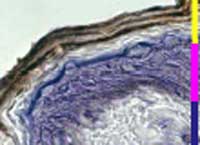 Engineered nanoparticles are at the forefront of the rapidly developing field of nanomedicine. Their unique size-dependent properties, of which optical and magnetic effects are the most used for biological applications, makes them suitable for a wide range of biomedical applications such as cell labeling and targeting, tissue engineering, drug delivery and drug targeting, magnetic resonance imaging, probing of DNA structure, tumor destruction via heating (hyperthermia), and detection and analysis of biomolecules such as proteins or pathogens. Many of these applications can also be tailored to target skin to help in the early diagnosis of a skin disease, which then could also be treated via nanocarriers. In addition, a tissue engineering approach could be useful for skin wound healing therapies and the magnetic properties of these particles might help in directing and localizing these agents in a particular layer of the skin where their action is desired. Unfortunately, if nanoparticles are able to penetrate layers of skin for therapeutic purposes, they might equally be able to penetrate skin unintentionally. This raises the question if people, who are exposed to such nanomaterials, could accidentally be contaminated and thus exposed to a potential local and/or systemic health risk. Researchers in Italy now have begun to systematically evaluate both risks and applications of nanoparticle skin absorption.
Engineered nanoparticles are at the forefront of the rapidly developing field of nanomedicine. Their unique size-dependent properties, of which optical and magnetic effects are the most used for biological applications, makes them suitable for a wide range of biomedical applications such as cell labeling and targeting, tissue engineering, drug delivery and drug targeting, magnetic resonance imaging, probing of DNA structure, tumor destruction via heating (hyperthermia), and detection and analysis of biomolecules such as proteins or pathogens. Many of these applications can also be tailored to target skin to help in the early diagnosis of a skin disease, which then could also be treated via nanocarriers. In addition, a tissue engineering approach could be useful for skin wound healing therapies and the magnetic properties of these particles might help in directing and localizing these agents in a particular layer of the skin where their action is desired. Unfortunately, if nanoparticles are able to penetrate layers of skin for therapeutic purposes, they might equally be able to penetrate skin unintentionally. This raises the question if people, who are exposed to such nanomaterials, could accidentally be contaminated and thus exposed to a potential local and/or systemic health risk. Researchers in Italy now have begun to systematically evaluate both risks and applications of nanoparticle skin absorption.
Apr 24th, 2007
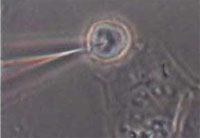 Biosensors, which incorporate biological probes coupled to a transducer, have been developed during the last two decades for environmental, industrial, and biomedical diagnostics. The application of nanotechnology to biosensor design and fabrication promises to revolutionize diagnostics and therapy at the molecular and cellular level. The convergence of nanotechnology, biology, and photonics opens the possibility of detecting and manipulating atoms and molecules using a new class of fiberoptic biosensing and imaging nanodevices. These nanoprobes and nanosensors have the potential for a wide variety of medical uses at the cellular level. The potential for monitoring in vivo biological processes within single living cells, e.g. the capacity to sense individual chemical species in specific locations within a cell, will greatly improve our understanding of cellular function, thereby revolutionizing cell biology. Existing nanoprobes have already demonstrated the capability of performing biologically relevant measurements inside single living cells.
Biosensors, which incorporate biological probes coupled to a transducer, have been developed during the last two decades for environmental, industrial, and biomedical diagnostics. The application of nanotechnology to biosensor design and fabrication promises to revolutionize diagnostics and therapy at the molecular and cellular level. The convergence of nanotechnology, biology, and photonics opens the possibility of detecting and manipulating atoms and molecules using a new class of fiberoptic biosensing and imaging nanodevices. These nanoprobes and nanosensors have the potential for a wide variety of medical uses at the cellular level. The potential for monitoring in vivo biological processes within single living cells, e.g. the capacity to sense individual chemical species in specific locations within a cell, will greatly improve our understanding of cellular function, thereby revolutionizing cell biology. Existing nanoprobes have already demonstrated the capability of performing biologically relevant measurements inside single living cells.
Mar 23rd, 2007
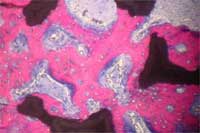 The market for medical implant devices in the U.S. alone is estimated to be $23 billion per year and it is expected to grow by about 10% annually for the next few years. Implantable cardioverter defibrillators, cardiac resynchronization therapy devices, pacemakers, tissue and spinal orthopedic implants, hip replacements, phakic intraocular lenses and cosmetic implants will be among the top sellers. Current medical implants, such as orthopaedic implants and heart valves, are made of titanium and stainless steel alloys, primarily because they are biocompatible. Unfortunately, in many cases these metal alloys with a life time of 10-15 years may wear out within the lifetime of the patient. They also might not achieve the same fit and stability as the original tissue, and in a worst case, the host organism might reject the implant altogether. While available implants can alleviate excruciating pain and allow patients to live more active lives, there often are problems getting bone to attach to the metal devices. Small gaps between natural bone and the implant can increase over time, requiring the need for additional surgery to replace the implant. In the quest to make bone, joint and tooth implants almost as good as nature's own version, scientists are turning to nanotechnology. Researchers have found that the response of host organisms (including at the protein and cellular level) to nanomaterials is different than that observed to conventional materials. While this new field of nanomedical implants is in its very early stage, it holds the promise of novel and improved implant materials.
The market for medical implant devices in the U.S. alone is estimated to be $23 billion per year and it is expected to grow by about 10% annually for the next few years. Implantable cardioverter defibrillators, cardiac resynchronization therapy devices, pacemakers, tissue and spinal orthopedic implants, hip replacements, phakic intraocular lenses and cosmetic implants will be among the top sellers. Current medical implants, such as orthopaedic implants and heart valves, are made of titanium and stainless steel alloys, primarily because they are biocompatible. Unfortunately, in many cases these metal alloys with a life time of 10-15 years may wear out within the lifetime of the patient. They also might not achieve the same fit and stability as the original tissue, and in a worst case, the host organism might reject the implant altogether. While available implants can alleviate excruciating pain and allow patients to live more active lives, there often are problems getting bone to attach to the metal devices. Small gaps between natural bone and the implant can increase over time, requiring the need for additional surgery to replace the implant. In the quest to make bone, joint and tooth implants almost as good as nature's own version, scientists are turning to nanotechnology. Researchers have found that the response of host organisms (including at the protein and cellular level) to nanomaterials is different than that observed to conventional materials. While this new field of nanomedical implants is in its very early stage, it holds the promise of novel and improved implant materials.
Mar 22nd, 2007
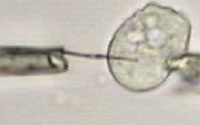 The assembly of nanoparticles along the external or internal surface of carbon nanotubes (CNTs) is of both fundamental and technological interest. Combining unique properties of CNTs and nanoparticles, the nanoparticle/nanotube composite structure attracts a broad range of advanced applications, including nanoelectronics, chemical and biosensors, catalysis and fuel cells. This so-called 'decoration' of CNTs has been used to increase the hydrogen storage capacity, to make nanotubes magnetic, or to grow secondary structures inside the nanotubes to increase the available surface for catalysis. In the case of interior wall decoration of CNTs, the internal cavity of the nanotube often is obstructed and no flow can be achieved or there could be release of the particles in the environment. In the case of exterior wall decorations, the particles enter in direct contact with the environment and may be lost during the nanotube handling. A novel technique of multifunctional nanotubes with controllable amounts of nanoparticles embedded in their walls during the synthesis process solves both problems leaving the CNT bore accessible and keeping the nanoparticles shielded from the environment by the CNT walls. This paves the way to using carbon nanotubes as nanoscale biological probes for sub-cellular investigation.
The assembly of nanoparticles along the external or internal surface of carbon nanotubes (CNTs) is of both fundamental and technological interest. Combining unique properties of CNTs and nanoparticles, the nanoparticle/nanotube composite structure attracts a broad range of advanced applications, including nanoelectronics, chemical and biosensors, catalysis and fuel cells. This so-called 'decoration' of CNTs has been used to increase the hydrogen storage capacity, to make nanotubes magnetic, or to grow secondary structures inside the nanotubes to increase the available surface for catalysis. In the case of interior wall decoration of CNTs, the internal cavity of the nanotube often is obstructed and no flow can be achieved or there could be release of the particles in the environment. In the case of exterior wall decorations, the particles enter in direct contact with the environment and may be lost during the nanotube handling. A novel technique of multifunctional nanotubes with controllable amounts of nanoparticles embedded in their walls during the synthesis process solves both problems leaving the CNT bore accessible and keeping the nanoparticles shielded from the environment by the CNT walls. This paves the way to using carbon nanotubes as nanoscale biological probes for sub-cellular investigation.
Mar 16th, 2007
 Most nanobiotechnology research today is focused on human medical applications and, mostly for testing and demonstration purposes, on animals. As nanotechnology is gaining interest with regard to agricultural applications, plant science research focusing on investigation of plant genomics and gene function as well as improvement of crop species has become a nanotechnology frontier. Plant cells differ from animal cells in several aspects, a major one being that they possess a wall surrounding them to provide, among other things, mechanical and structural support. The plant cell wall is generally made up of pollysacharides and cellulose. Cellulose provides a stiff and rigid environment for the cell to live in. Thanks to this wall, viruses have no active way of penetrating plant cells but rely on mechanical wounds or infected seeds for transmission. Researchers are commonly using surface-functionalized silica nanoparticles as nonviral nanocarriers for experimental drug and DNA delivery into animal cells but their use with plants so far was limited due to the cell wall. In a first demonstration of the utilization of porous nanoparticle materials for intracellular controlled release and gene transfer application in plants, researchers have used silica nanoparticles to penetrate the cell wall and deliver a payload into the cell.
Most nanobiotechnology research today is focused on human medical applications and, mostly for testing and demonstration purposes, on animals. As nanotechnology is gaining interest with regard to agricultural applications, plant science research focusing on investigation of plant genomics and gene function as well as improvement of crop species has become a nanotechnology frontier. Plant cells differ from animal cells in several aspects, a major one being that they possess a wall surrounding them to provide, among other things, mechanical and structural support. The plant cell wall is generally made up of pollysacharides and cellulose. Cellulose provides a stiff and rigid environment for the cell to live in. Thanks to this wall, viruses have no active way of penetrating plant cells but rely on mechanical wounds or infected seeds for transmission. Researchers are commonly using surface-functionalized silica nanoparticles as nonviral nanocarriers for experimental drug and DNA delivery into animal cells but their use with plants so far was limited due to the cell wall. In a first demonstration of the utilization of porous nanoparticle materials for intracellular controlled release and gene transfer application in plants, researchers have used silica nanoparticles to penetrate the cell wall and deliver a payload into the cell.
 Subscribe to our Nanotechnology Spotlight feed
Subscribe to our Nanotechnology Spotlight feed





